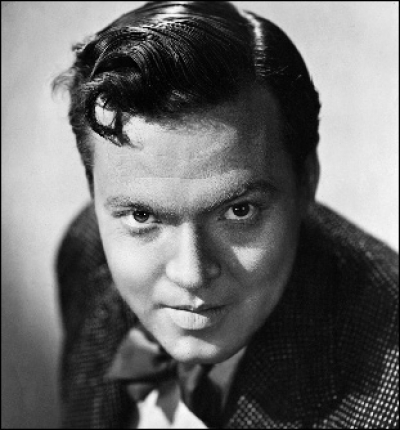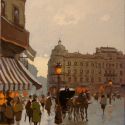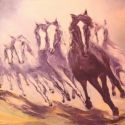
photo: http://dinamico2.unibg.it/fa/imgs/welles.jpg
Biography
Early career
Welles was born in 1915 in Kenosha, Wisconsin. He had an unusual childhood, being somewhat of a prodigy, and his personal relationships suffered as a result. His mother died when he was nine, and his father, Richard Head Welles, receded into the past, an alcoholic.
Welles performing in his 1938 radio adaptation of The War of the Worlds.
Welles performed and staged his first theatrical productions while attending the Todd School for Boys in Woodstock, Illinois and was brought under the guidance of the principal, Roger Hill, who became a surrogate father to Welles. While there he was also tutored by Dorothy Hartshorne, a singer and wife of late theologian-philosopher Charles Hartshorne. He made his stage debut at the famous Gate Theatre in Dublin, Ireland in 1931 when he talked himself onto the stage and appeared in small supporting roles, and by 1934 was a radio director/actor in the United States, working with some of the cast that later became the Mercury Theatre. In that year, the brown-eyed actor married the actress and socialite Virginia Nicholson; Welles also co-directed and starred in a short silent film, unintended for commercial release, titled The Hearts of Age, which also featured Nicholson.
Renown in Theater and Radio
In 1936, the Federal Theatre Projects began putting theatre performers and employees to work with projects that were intended for the masses. Welles came to their attention, and at the age of only 21, he was assigned to direct a project in Harlem with a group of African-American performers and stagehands. At the suggestion of his wife, he decided to produce Macbeth but set it in Haiti, in the court of King Henri Christophe. While the play attracted its share of critics and detractors during pre-production, the show opened to rave reviews and sold out box offices.
After the success of Macbeth, Welles began producing and directing other shows, such as Dr. Faustus and a satire, Horse Eats Hat. In 1937, Welles was producing the pro-labor show, The Cradle Will Rock, when the Federal Theatre Project, aware of its subject matter, closed the theater on the day of its first dress rehearsal. In a move that would become legendary, Welles and his producing partner, John Houseman, decided to wait till almost curtain time to announce to the ticket holders standing outside the theater that the show was moving to another theater. The cast, crew and audience then proceeded to march to another theater eleven blocks away. The show began, with its writer, Marc Blitzstein, introducing the show and playing the accompanying piano on stage. Since the unions wouldn't permit the actors or musicians to perform the show (naturally on the stage), the musicians and actors performed the show from the audience seats. The show was a hit.
With his theater success, Welles and Houseman decided to form their own theater company, the Mercury Theatre. Their first show was a production of Shakespeare's Julius Caesar. With fascism sweeping through Europe, Welles imagined the main characters in Nazi-type uniforms, with Nuremburg-type lights and a fascist theme to the settings. Not only was the play an enormous success, but some theater critics have said that it was among the best performances of Shakespeare in American theater history.
While setting Broadway on fire, Welles was very active in radio as well, first as an actor and soon as a director/producer. He began playing The Shadow in late 1937, and in the summer of 1938 Welles and the Mercury Theatre began weekly broadcasts of short radio plays based on classic or popular literary works. Their October 30 broadcast of that year was an adaptation of The War of the Worlds. This brought Welles his first public notoriety on a national level, as the program created panic among some listeners who found it completely convincing. Welles's adaptation of H. G. Wells' classic novel simulated a news broadcast, cutting into a routine dance music program to describe the landing of Martian spacecraft in Grover's Mill, New Jersey. The innovative broadcast was realistic enough to frighten many in the audience into believing that an actual Martian invasion was in progress. Recordings of the broadcast are still available (see old-time radio and also the UK Region 2 DVD of Citizen Kane). The publicity that resulted from this led to Campbell's Soup sponsoring the previously unsponsored Mercury Theatre on the Air and eventually the offer of a three-picture Hollywood contract from RKO Pictures. Welles continued working extensively in radio throughout the 1940s, though his success there had its ups and downs as did his movie career. The cast of The Mercury Theatre even made the move to Hollywood with him, and The Campbell Playhouse moved its broadcast from New York to Hollywood as well.
Among the other radio series Welles produced and directed were:
The Orson Welles Show, for sponsor Lady Esther;
Hello Americans, which presented the music and research Welles was denied using for his unfinished film It's All True; Ceiling Unlimited, a patriotric wartime salute to sponsor Lockheed/Vega; The Orson Welles Almanac, a touring show sponsored by Mobil Oil, featuring Welles dabbling with comedy and magic; and Orson Welles' Commentaries, a political commentary show.
Commentaries, the last series Welles would do in the US, caused a firestorm when Welles championed the cause of Isaac Woodward, a black World War II vet who had been beaten and blinded by a racist white policeman. The controversy led to Welles' film The Stranger being banned in the South.
After Welles starred as Harry Lime in the film The Third Man, he reprised the same character for a BBC radio series titled The Lives of Harry Lime during 1951-52. Welles also hosted and narrated another BBC series The Black Museum, which dramatized famous cases from Scotland Yard's "Museum of Death."
Welles in Hollywood
Welles toyed with various ideas for his first project for RKO, settling briefly on an adaptation of Joseph Conrad's Heart of Darkness before ultimately rejecting it when the studio's budget projections made it impractical. In a display of his avant-garde sensibility, Welles planned to film the action entirely from the protagonist's point of view. With his initial ideas bearing no fruit, Welles finally found a suitable project in an idea suggested by screenwriter Herman Mankiewicz. Initially called American, it would eventually become Welles' first feature film, Citizen Kane (1941).
Citizen Kane, directed by and starring Orson Welles, is here commemorated on a postage stamp.
Welles was once again the center of controversy with Citizen Kane. The gossip writer Louella Parsons convinced the yellow-press magnate, William Randolph Hearst, that he was the basis for Kane, with the result that Hearst's media empire boycotted the film. On its release, this event overshadowed the film's radical formal innovations. Welles is said to have sardonically remarked, in response to Hearst's attitude, that if he were to do a movie about the journalism magnate, the fact would be more grand and shockingly unbelievable than the fiction. This possibly apocryphal quote is uttered by Liev Schreiber (as Welles) in the 1999 TV movie RKO 281.
Welles' second film for RKO was the more traditional The Magnificent Ambersons, adapted from the Pulitzer Prize-winning novel by Booth Tarkington, and on which RKO executives hoped to make back the money lost by Citizen Kane's relative commercial failure.
Simultaneously, Welles worked on a spy thriller, Journey Into Fear, which he co-wrote with Joseph Cotten. In addition to acting in the film, Welles was also a producer. Direction was credited solely to Norman Foster, but the film contains several expressionistic sequences indicating input by Welles. Welles denied having directed the film, but the visual style is very similar to his credited works. Whatever the case, Welles played a major role in its production, but he expressed disappointment at the released version, which was severely edited by RKO.
During the production of Ambersons, Welles was asked to make a documentary film about South America on behalf of the government. Welles left the United States to begin shooting this documentary after putting together the first rough cut of The Magnificent Ambersons, on the understanding that further editing decisions would be carried out via telegram. RKO, however, was in a perilous financial situation and feared another commercial failure. The studio wrested control of the film from Welles' Mercury Productions staff, cut over fifty minutes of footage, and added a reshot, upbeat ending. The cut footage, including Welles's original ending to the film, has been lost. This event marked the beginning of a recurring pattern in Welles' Hollywood career of damaging executive interference. Welles' South American documentary, titled It's All True, never saw completion in his lifetime. The surviving footage was released in 1993.
Welles and Rita Hayworth in a publicity still for The Lady from Shanghai.
In 1946, International Pictures released Welles' film The Stranger, starring Edward G. Robinson and Loretta Young as well as Welles himself. Sam Spiegel produced the film, which gave Welles an opportunity to salvage – briefly – his reputation in Hollywood. A noir-ish suspense film about the hunt for a Nazi war criminal, The Stranger was Welles' only commercial success as a director. Welles supposedly made the film to prove that he could make a conventional picture within time and budget constraints. He followed The Stranger with another noir drama for Columbia Pictures, The Lady from Shanghai. Welles played the protagonist, while his second wife, Rita Hayworth, played one of the villains. Like The Magnificent Ambersons, The Lady from Shanghai suffered heavy editing by its studio, with approximately an hour removed from Welles' final cut. The excised portions have been lost. Welles' notes for the film suggest that these portions would have aided audiences' comprehension of the story. Despite the editing, the theatrical cut still contains many examples of Welles' expressionist filmmaking. Once released, the film was savaged by critics for its convoluted plot, and audiences disliked Hayworth as a villain. Welles' marriage to Hayworth, already troubled during filming, ended shortly after the production wrapped.
Welles changed studios once again, moving to Republic Pictures, a studio with a reputation for making B movies. The move marked a return to Shakespeare for Welles—he chose to direct and star in an idiosyncratic production of Macbeth. Working with a very limited budget, Welles fashioned a Macbeth that emphasized the darkness of the play's themes and characters. Unfortunately for Welles, the released version (trimmed, at Republic's behest, of around twenty minutes of footage, including a ten-minute take) once again proved unpalatable to the movie-going public.
Welles after Hollywood
Orson Welles (right) as Harry Lime in The Third Man.
Frustrated by his experience with the studio system, Welles left Hollywood in 1948.
Another possible reason of his leaving the US, among others, has been explained by Welles expert Mark W. Estrin: "J. Edgar Hoover’s now documented fear that Welles was a dangerous Communist confirms that he had become a logical target for the McCarthy witch-hunting crowd in Congress as well. Although IRS tax trouble was another contributing factor, it cannot have been entirely coincidental that Welles worked in Europe from 1948 until 1955." (Orson Welles, Interviews, ed. Mark W. Estrin, Jackson, UP of Mississippi, 2002, xvii). This theory has also been put forward by Welles' friend (and interviewer for This Is Orson Welles) Peter Bogdanovich.
The following year Welles made one of his most notable film appearances in The Third Man, reuniting him with Joseph Cotten to whom Welles (as Harry Lime) gave the celebrated "Cuckoo Clock" speech:
In Italy for 30 years under the Borgias they had warfare, terror, murder, and bloodshed, but they produced Michelangelo, Leonardo da Vinci and the Renaissance. In Switzerland they had brotherly love—they had 500 years of democracy and peace, and what did that produce? The cuckoo clock.
This is the only piece of dialogue in the film which its screenwriter Graham Greene did not write: Welles penned it himself and insisted that it be put in. Greene is reputed to have hated it (possibly because the cuckoo clock was not, in fact, a Swiss invention). Welles' appearance was relatively brief, but his character dominates the film.
From 1949 to 1952, Welles worked on Othello, filming the entire work on location in Europe and Morocco. Despite winning the Palme d'Or at the Cannes Film Festival, the film was not at the time given a general release in the United States, and played only in New York and Los Angeles. In 1992, the American release version of this film was restored from a nitrate negative that had been feared lost and went on a successful theatrical run in America. The entire score was rerecorded, and the film is now generally viewed as the most satisfactory film adaptation of the play.
The corrupt Capt. Hank Quinlan (Orson Welles, left) faces off against honest Mexican cop Mike Vargas (Charlton Heston) during the interrogation scene in Touch of Evil.
In 1958, he made his final return to Hollywood when Charlton Heston convinced Universal to give Welles a shot at writing and directing the adaptation of Whit Masterson's pulp novel in Touch of Evil. Despite being filled with revolutionary lighting and camera techniques, as well as what is obviously a precursor to Hitchcock's Psycho, the film was once again wrestled from Welles' hands and severely cut down and reshot. Welles protested, writing a 58-page memo outlining his objections to the studio's version, but his comments were ignored. The film was released as the B-picture on a double-bill with Harry Keller's The Female Animal, but was widely praised across Europe, awarded the top prize at the Brussels World's Fair by judges (and then critics) Francois Truffaut and Jean-Luc Godard, who both cited it as being highly influential on their own respective debuts, The 400 Blows (1959) and Breathless (1960). (In 1998, editor Walter Murch, working from the original memo and a workprint version, restored the film to Welles's original vision.)
After this last attempt at working within the studio system, Welles spent the rest of his directorial career in Europe, his films self-financed from acting fees or, later, funded by sympathetic producers. On almost all of these projects he retained final cut, but the independence thus gained also resulted in drastically reduced budgets and technical facilities. Despite these setbacks, some of Welles' best work was produced during this period from 1948 until his death in 1985.
Television
A lesser known, but still important, aspect of Welles' career was his work in television. The Orson Welles Sketchbook (1955) was created for the BBC and featured Welles telling stories and drawing pictures to illustrate them. The director also created Around the World with Orson Welles (1955) for the BBC. In this series he gleefully experimented with a film-essay format, foreshadowing the later F for Fake (1974). The Fountain of Youth (1958) was made for American TV and in it Welles offers some possibilities for expanding the medium's vocabulary. The Immortal Story (1968) was filmed for French television and stars not only Welles himself, but also Jeanne Moreau, one of the most loved actresses of the French New Wave cinema; based on a short story by Isak Dinesen, it is a spare and somber meditation on old age, isolation, and the inability to create. One of his most playful efforts was Portrait of Gina (1958), in which the director/narrator wanders through Italy, finally arriving at Gina Lollobrigida's home at the end of the film. Welles continued to work in TV through the1960s, 70s and 80s, but little of the work he directed from this period was ever broadcast. A version of The Merchant of Venice (1969) was not completed because a reel was stolen and never recovered. Clips from unfinished TV projects appear in the documentary Orson Welles: The One-Man Band (1995), a fascinating but bittersweet look at many of the director's varied unreleased projects.
Unfinished projects
Welles' exile from Hollywood and reliance on independent finance meant that many of his later cinema projects were filmed in a piecemeal fashion and some were not completed at all. In the mid 1950s Welles began work on a film adaptation of Cervantes' Don Quixote, initially on a commission from CBS television. CBS was unhappy with the original half hour television play and rejected the footage. Welles gleefully took this as an opportunity to expand the film to feature length, developing the screenplay to take Quixote and Sancho Panza into the modern age (an idea that later formed the basis of Jean-Marie Poiré's Les Visiteurs). Filming continued in a fragmentary fashion for a number of years whenever cast and crew could be assembled in one place. The project was finally abandoned with the death of Francisco Reiguera, the actor playing Quixote, in 1969. An incomplete version of the film was released in 1992.
John Huston, Orson Welles and Peter Bogdanovich on the set of The Other Side of the Wind.
In 1970 Welles began shooting The Other Side of the Wind. Finance was from a number of sources, the largest of which being an Iranian company based in Paris and run by the brother-in-law of the Shah of Iran. The film is apparently the story of the efforts of a film director (played by John Huston) to complete his last Hollywood movie and is largely set at a lavish party. Although in 1972 the film was reported by Welles as being "96% complete" its legal ownership became a matter of dispute. Argument continued for a number of years until the 1979 Iranian Revolution effectively consigned it to a legal limbo. The negative remained in a Paris vault until in 2004 when Welles' friend Peter Bogdanovich (who also acted in the film) announced his intention to resolve the legal difficulties and complete the production. Footage from the film is included in the documentary Working with Orson Welles (1993)
Other unfinished projects include an adaptation of Charles William's The Deep, abandoned due to the death of Laurence Harvey despite being one scene away from completion and The Big Brass Ring, the script of which was adapted and filmed by US-director George Hickenlooper in 1999.
Mark Millar wrote an article about a failed Orson Welles Batman project. This generated a considerable amount of buzz, especially on Ain't It Cool News, but the rumor has since been proven false. Welles did, at one point prior to Kane, consider reprising his role as Lamont Cranston for a Shadow film project. But, as with the mooted film adaptation of War of the Worlds, he opted to forego these commercial projects in favor of more personal works.
Final years
Because of his self-imposed Hollywood exile, Welles had to resort to advertisement campaigns in his later years for funding.
A man known for his large appetites, Welles became overweight in his later years, at one point reaching around 350 pounds. The Monty Python troupe, who won the Jury's Prize in the Cannes Film Festival for The Meaning of Life in 1982, remarked that Orson Welles, who was on the Cannes jury panel, looked remarkably like the Mr. Creosote character from the film. He capitalized on his image in various advertising campaigns for certain brands of wines, hot dogs, and correspondence courses. A bootleg of the recording session for one of his later commercials still circulates on the Internet and elsewhere, often known simply as Frozen Peas. In the recording, Welles can be heard criticizing the commercial's producers for its poor script and their "impossible, meaningless" directions, before walking out on the session, telling them that "no money is worth this" (This incident was later satirized on SCTV with John Candy playing Welles, trying and failing to get through a reading of Good King Wenceslas before storming off set with the same lines as on the bootleg.) Another bootlegged recording features a clearly inebriated Welles struggling, and failing, to get through his lines in a commercial for a California champagne. The Fox show "The Critic" also satarized this moment, with Welles trying to see "Rosebud Forzen Peas", even using the phrase "rosebud" in black and white first. The peas were full of "Country goodness and green pea-ness". He then said that the lines were terrible, and he quit, not before taking a handful of frozen peas to eat as he left.
During his career he won one Oscar and was nominated for a further four. Among his later film appearances were as Father Mapple in John Huston's Moby-Dick (1956), as Cardinal Wolsey in A Man for All Seasons (1966), and as General Dreedle in Mike Nichols's Catch-22 (1970). In 1971 the Academy gave him an honorary award "For superlative artistry and versatility in the creation of motion pictures".
After dieting and losing 50 pounds, Welles died of a heart attack in Hollywood, California at the age of 70 on October 10, 1985 (the same day as Yul Brynner). At the time of his death he had been working on various projects, including The Dreamers, a film adaptation of two stories by Isak Dinesen, around twenty-five minutes of which had already been shot.
The final role Welles performed in a released film was that of the planet-eater Unicron in the animated Transformers: The Movie, recording his lines mere weeks before his passing. However, it was not his last appearance on the screen, as the previously-filmed 1987 independent movie Someone To Love, was released two years following his death. His last TV appearance was in the introduction of the episode "The Dream Sequence Always Rings Twice" of the series Moonlighting. Welles also recorded a narration for the The Alan Parsons Project's Tales of Mystery and Imagination, however this was never included on the original release. It was, however included in the 1987 remix released on CD.
Welles' ashes were placed at the estate of a friend in Ronda, Spain, at his request. Some reports mention that some of his ashes may have been scattered in the town's famous Plaza de Toros, the oldest bullfighting ring in Spain that is still used. Prominent critic Geoff Andrew has said, 'He remains that rarity – a genius of the cinema.'
Trivia
While many consider his greatest work to be Citizen Kane, Welles personally saw The Trial and Chimes at Midnight as his most rewarding achievements, and considered The Stranger to be the least of his films. It was Orson Welles who suggested to Peter Bogdanovich to film The Last Picture Show in B&W.
Orson Welles' distinctive voice was used in Warner Bros. animated cartoon Pinky and The Brain, with Maurice LaMarche providing the voice of The Brain with a dead-on impersonation of Welles. This impersonation was also used in Tim Burton's film Ed Wood with Vincent D'Onofrio as Welles with LaMarche's voice dubbed over. The ghost-written novel Mr. Arkadin.
The novel Mr. Arkadin, supposedly written by Orson Welles, is in fact ghost-written by Maurice Bessy - Welles has stated that he had no idea about its existence until he saw it in a bookstore.
As a child he was deeply fascinated by conjuring, both stage and close up. There is a myth that the young Welles was taught magic by Harry Houdini when he was 5 years old. He travelled with a magic act on several occasions throughout his adult life. His interest in the psychology employed by a magician surfaced in much of his film-making. For example, in Citizen Kane, during the dialogue in the famous puzzle scene with his wife Susan Alexander, Kane walks back in the shot to stand near the fireplace. He is unexpectedly dwarfed by the fireplace; a visual representation of his downward decline. The optical illusion obtained by Welles employs principles of 'manipulation of perspective' used by magicians.
Welles was notorious for not rehearsing his lines while doing The Shadow on the radio. Reportedly Welles believed it gave the show a greater urgency because he was letting the story unfold before him and the audience at the same time. There are a number of apocryphal stories where Welles was reported to have turned to an actor during the mid-show commercial break and commented that this week's story was fascinating and he couldn't wait to "find out how it all ends." Welles admitted to preferring the cold-reading style in his on-air performances as he described the hectic nature of radio work to Peter Bogdanovich in the interview-style biography This Is Orson Welles:
Soon I was doing so many [programs] that I didn't even rehearse. I'd come to a bad end in some tearjerker on the seventh floor of CBS and rush up to the ninth (they'd hold an elevator for me), where, just as the red light was going on, somebody'd hand me a script and whisper, "Chinese mandarin, seventy-five years old", and off I'd go again[...]Not rehearsing[...]made it so much more interesting. When I was thrown down the well or into some fiendish snake pit, I never knew how I'd get out.
Initially, George Lucas wanted to use Orson Welles' voice for Darth Vader in Star Wars, as he had always intended to replace the voice of British bodybuilder David Prowse, who was the character's physical form and performed the dialogue during the shooting. However, Lucas wanted a darker, more sinister voice, and later took into consideration the fact that Welles' mysterious baritone was too familiar, and instead chose a relatively unknown veteran character actor and classically-trained thespian named James Earl Jones. However, Welles did perform the narration for the film's first trailer, released in late 1976.
Orson Welles was Francis Ford Coppola's first choice to play Colonel Kurtz in Apocalypse Now (1979), based on the novel Heart of Darkness which Welles was planning to adapt before he wrote Citizen Kane.
His obesity and early death were attributed to his regular dinner: two steaks and a pint of scotch. During his early years, especially while filming Citizen Kane, Welles' entire dinner menu also included a full pineapple, triple pistachio ice cream, and a full bottle of scotch.
According to Simon Callow's biography (Orson Welles: The Road to Xanadu), a 1941 physical lists the then 26-year old Welles as being 72 inches tall, and weighing 218 pounds.
He also narrated pieces for the Odinist heavy metal band Manowar, on their Battle Hymns (1982) and Fighting The World (1987) albums, the latter released two years after Welles' death. He was born on the same day that Babe Ruth hit his very first home run.
On Alan Parsons's 2004 release A Valid Path, Welles was again featured on the song "A Reoccurring Dream Within A Dream". His line goes as follows: "For my own part, I have never had a thought which I could not set down in words with even more distinctness that that which I can conceive to."
Selected filmography
Directed by Welles
Citizen Kane (1941) - won Oscar for Best Writing (Original Screenplay); nominated for Best Actor, Best Picture and Best Director.
The Magnificent Ambersons (1942) - nominated for Oscar for Best Picture; shortened and recut against Welles's wishes, footage forever lost
The Stranger (1946)
The Lady from Shanghai (1947) - shortened and recut against Welles's wishes, footage forever lost
Macbeth (1948) - shortened and recut against Welles's wishes, recently restored to original vision
Othello (1952) - won the Palme d'Or, 1952 Cannes Film Festival
Mr. Arkadin (aka Confidential Report) (1955) - shortened and recut against Welles's wishes, Criterion's restoration announced for April 2006.
Touch of Evil (1958) - won the top-prize at the Brussels World's Fair; shortened and recut against Welles' wishes, recently restored to original vision
The Trial (1962)
Chimes at Midnight (1965)
The Immortal Story (1968)
The Deep (1970) - unfinished
The Other Side of the Wind (1970-76) - currently unreleased, restoration in progress
F for Fake (aka Vérités et mensonges) (1974)
Other notable films
Hearts of Age (1934) - Welles' first foray into film, a silent, one-reel piece he made at age 18
Too Much Johnson (1938)
Swiss Family Robinson (1940) - narration
It's All True (1942)
Journey Into Fear (1943) - actor, rumored to be co-director with Norman Foster. Welles denied he directed it.
Jane Eyre (1944) - actor (Rochester)
Duel in the Sun (1946) - narration
Monsieur Verdoux (1947) - story idea
The Third Man (1949)- actor, dialogue
Moby Dick (1956) - cameo role as actor
Man in the Shadow (1957) - actor
Compulsion (1959) - actor
A Man for All Seasons (1966) - actor
I'll Never Forget What's'isname (1967) - actor
Casino Royale (1967) - cameo role as actor
Don Quixote (1969, version released 1992) - writer, director, actor
Start the Revolution Without Me (1970) - narration, cameo role
Catch-22 (1970) - actor
Waterloo (1970) - actor
The Muppet Movie (1979) - cameo
History of the World, Part One (1981) - narration
The Dreamers (1980-82, unfinished) - actor, writer, director
Transformers: The Movie (1986) - voice actor
Further reading
Cowie, Peter. The Cinema of Orson Welles, Da Capo Press, 1973.
Heylin, Clinton. Despite the System: Orson Welles Versus the Hollywood Studios, Chicago Review Press, 2005.
Mac Liammóir, Micháel. Put Money in Thy Purse: The Filming of Orson Welles' Othello, Methuen, 1976.
McBride, Joseph. Orson Welles, Da Capo Press, 1996.
Naremore, James. The Magic World of Orson Welles, Southern Methodist University Press, 1989.
Naremore, James. Citizen Kane: A Casebook, Oxford University Press, 2004.
Welles, Orson et al. This is Orson Welles, Da Capo Press, 1998.
Higham, Charles. ""Orson Welles: The Rise and Fall of an American Genius"", St. Martin's Press, 1985

































